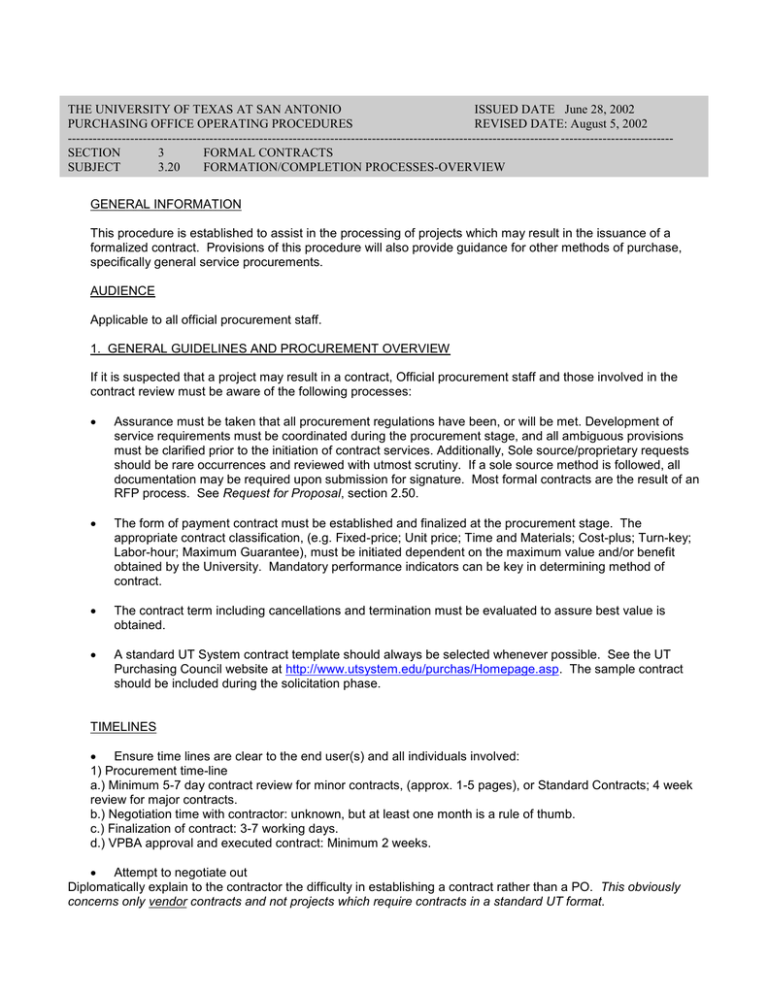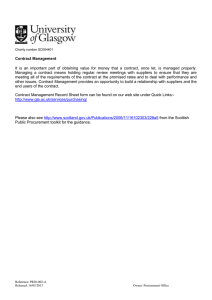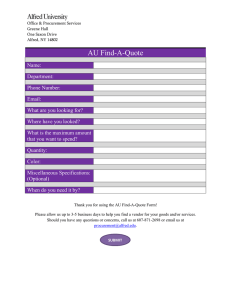THE UNIVERSITY OF TEXAS AT SAN ANTONIO PURCHASING OFFICE OPERATING PROCEDURES
advertisement

THE UNIVERSITY OF TEXAS AT SAN ANTONIO ISSUED DATE June 28, 2002 PURCHASING OFFICE OPERATING PROCEDURES REVISED DATE: August 5, 2002 ---------------------------------------------------------------------------------------------------------------------- --------------------------SECTION 3 FORMAL CONTRACTS SUBJECT 3.20 FORMATION/COMPLETION PROCESSES-OVERVIEW GENERAL INFORMATION This procedure is established to assist in the processing of projects which may result in the issuance of a formalized contract. Provisions of this procedure will also provide guidance for other methods of purchase, specifically general service procurements. AUDIENCE Applicable to all official procurement staff. 1. GENERAL GUIDELINES AND PROCUREMENT OVERVIEW If it is suspected that a project may result in a contract, Official procurement staff and those involved in the contract review must be aware of the following processes: Assurance must be taken that all procurement regulations have been, or will be met. Development of service requirements must be coordinated during the procurement stage, and all ambiguous provisions must be clarified prior to the initiation of contract services. Additionally, Sole source/proprietary requests should be rare occurrences and reviewed with utmost scrutiny. If a sole source method is followed, all documentation may be required upon submission for signature. Most formal contracts are the result of an RFP process. See Request for Proposal, section 2.50. The form of payment contract must be established and finalized at the procurement stage. The appropriate contract classification, (e.g. Fixed-price; Unit price; Time and Materials; Cost-plus; Turn-key; Labor-hour; Maximum Guarantee), must be initiated dependent on the maximum value and/or benefit obtained by the University. Mandatory performance indicators can be key in determining method of contract. The contract term including cancellations and termination must be evaluated to assure best value is obtained. A standard UT System contract template should always be selected whenever possible. See the UT Purchasing Council website at http://www.utsystem.edu/purchas/Homepage.asp. The sample contract should be included during the solicitation phase. TIMELINES Ensure time lines are clear to the end user(s) and all individuals involved: 1) Procurement time-line a.) Minimum 5-7 day contract review for minor contracts, (approx. 1-5 pages), or Standard Contracts; 4 week review for major contracts. b.) Negotiation time with contractor: unknown, but at least one month is a rule of thumb. c.) Finalization of contract: 3-7 working days. d.) VPBA approval and executed contract: Minimum 2 weeks. Attempt to negotiate out Diplomatically explain to the contractor the difficulty in establishing a contract rather than a PO. This obviously concerns only vendor contracts and not projects which require contracts in a standard UT format. 2. CONTRACT FORMATION AND COMPLETION Secure the contract electronically. Track the contract in and establish file. See Contract Numbering System, Section 3, Subject 3.30. Review contract to ensure clarity of issues such as, but not limited to, the following: Payment terms; Invoicing procedures, (major service contracts normally require invoicing directly to the department administrator); Termination and Cancellation procedures; General contract terms, Parties to contract; Deliverables; Scope of work; Performance indicators; Schedules; and Insurance and bonds if necessary. Review the Procurement Contract Checklist in Attachment A, which includes completing the appropriate OGC checklist. Change what is understandable, and notate what is not. (NOTE: It may be more efficient to complete the procurement contract routing checklist in its entirety at the time the contract is ready for release and execution--however procurement staff must be aware of the requirements). Route to Senior Buyer with recommendations. Route to Contracts for review. When applicable, a contract prepared for execution should contain the three pertinent drafts of the contract, (two originals signed by the contractor), appropriate checklists, bonds and insurance, and supporting documentation. These should all be labeled and organized in file folders. The contract is routed to VPBA through the department's Executive Officer for signing and execution. IMPORTANT: Keep a copy of entire packet that has been routed to VPBA. VPBA will maintain one original, and route the other to Purchasing for submission to contractor. Upon receipt of executed contract, review, distribute and explain the Departmental Contract Administration Guidelines to the departmental project administrator(s), and necessary personnel as appropriate. See Attachments B and C. A post-contract meeting may be necessary. Place executed copy with file, and ensure tracking is completed. 3. ADDITIONAL NOTES: * Projects resulting in a formalized executed contract do not require the issuance of a PO, as this may result in conflicting or duplicate terms and conditions. If a PO is not issued, a copy of the contract notating contract number, along with any relevant information, should be submitted to the Disbursement's Manager in place of the PO to ensure payment. The contract number will be referenced on all payments. Procurement Assistants must be notified of these individual transactions in order to complete appropriate breakdown, tracking, and filing procedures. * All amendments to major contracts should be tracked for amendment number and financial information. * Vendor payment forms will be returned from the Disbursements Office for tracking of vendor performance. ATTACHMENTS: A: B: C: Routing Checklist Department Guide for Administration of Major Service Contracts Payment Form

